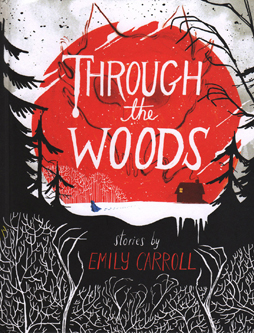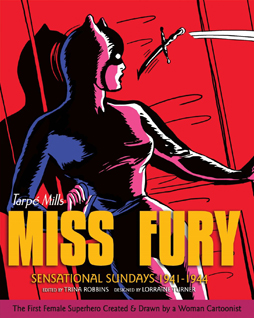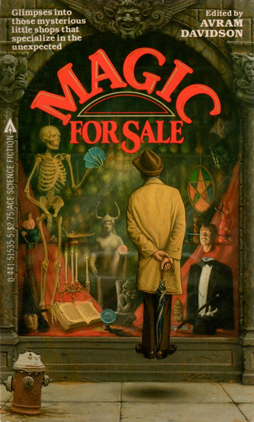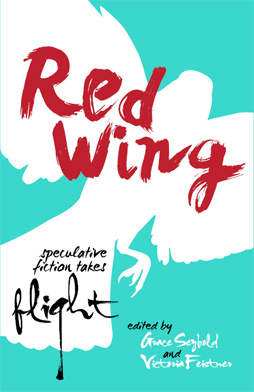Through the Woods and Other Stories by Emily Carroll
 And now for some utterly uncontroversial awards news: on April 22, the nominees for the 2015 Eisner Awards were announced. You can find the complete list here, representing some very impressive work. I’ve written in the past about Astro City, Sandman: Overture, and Saga; I want to take a moment now to write a bit about one of the other nominees. Emily Carroll’s up for two Eisners, ‘Best Graphic Album — Reprint’ for her anthology Through The Woods, and ‘Best Short Story’ for her online piece “When the Darkness Presses.” They’re both excellent.
And now for some utterly uncontroversial awards news: on April 22, the nominees for the 2015 Eisner Awards were announced. You can find the complete list here, representing some very impressive work. I’ve written in the past about Astro City, Sandman: Overture, and Saga; I want to take a moment now to write a bit about one of the other nominees. Emily Carroll’s up for two Eisners, ‘Best Graphic Album — Reprint’ for her anthology Through The Woods, and ‘Best Short Story’ for her online piece “When the Darkness Presses.” They’re both excellent.
I first stumbled across Carroll’s comics shortly before the Eisner nominations were made public. I found a copy of Through The Woods at my local library, after which I read through the short stories on Carroll’s web site. I thought both the print and online works were brilliant comics. Mostly horror or dark fantasy with a strong mythic edge, they experiment with form in order to get at the heart of their narratives. Panel designs and lettering and storytelling are all unobtrusively intelligent and quietly inventive, finding new ways to bring out the emotional textures of the tales.
Carroll changes her style and approach with each story, but maintains a distinctive voice. She moves easily from web to print, working with the possibilities of page design in both mediums in a way that feels not just accomplished but effortless. Reading through her work you’re struck by the range of approaches but also by the sense of an overall unity — the unity that emerges from a major artist exploring the themes that hold meaning for her.

 In 1941 comics artist June Tarpé Mills started a new Sunday adventure strip: Miss Fury. It would run until 1952, telling the wild and beautifully-drawn saga of a socialite who donned a magical black cat-suit to fight Nazis and criminals. In 2011 IDW’s Library of American Comics imprint published a selection of Miss Fury strips from 1944 through 1949, edited and with an introduction by comics historian Trina Robbins. Last year Robbins and IDW published a second volume, collecting the series from the start up to the beginning of the earlier collection, again featuring an introduction about Mills and her strip, and as well a brief selection of some of Mills’ earlier work. I had a chance to read the recently-published second collection, and was tremendously impressed.
In 1941 comics artist June Tarpé Mills started a new Sunday adventure strip: Miss Fury. It would run until 1952, telling the wild and beautifully-drawn saga of a socialite who donned a magical black cat-suit to fight Nazis and criminals. In 2011 IDW’s Library of American Comics imprint published a selection of Miss Fury strips from 1944 through 1949, edited and with an introduction by comics historian Trina Robbins. Last year Robbins and IDW published a second volume, collecting the series from the start up to the beginning of the earlier collection, again featuring an introduction about Mills and her strip, and as well a brief selection of some of Mills’ earlier work. I had a chance to read the recently-published second collection, and was tremendously impressed. Recently, Black Gate overlord John O’Neill
Recently, Black Gate overlord John O’Neill  Last week,
Last week,  At a science fiction book sale not too long ago, I picked up an anthology from 1983 called Magic For Sale. There was something irresistibly appropriate in buying the book second-hand: edited by Avram Davidson, it’s a collection of stories for the most part precisely about the magic that lies within the second-hand. About purchasable goods with something in them beyond cost and explanation. About shoppers who find more than they expected. About supernatural bargains, each with its own twist.
At a science fiction book sale not too long ago, I picked up an anthology from 1983 called Magic For Sale. There was something irresistibly appropriate in buying the book second-hand: edited by Avram Davidson, it’s a collection of stories for the most part precisely about the magic that lies within the second-hand. About purchasable goods with something in them beyond cost and explanation. About shoppers who find more than they expected. About supernatural bargains, each with its own twist. Usually I write here about books I’ve read and enjoyed. It’s really quite selfish: thinking about a good book extends the pleasure I get from reading it. This post, though, is a little different. I’m going to write about a science fiction trilogy in order to work out why I don’t like it more than I do. These are good books, even excellent books. But something about them didn’t grip me the way I would have thought they might.
Usually I write here about books I’ve read and enjoyed. It’s really quite selfish: thinking about a good book extends the pleasure I get from reading it. This post, though, is a little different. I’m going to write about a science fiction trilogy in order to work out why I don’t like it more than I do. These are good books, even excellent books. But something about them didn’t grip me the way I would have thought they might. There’s a new anthology out that I want to talk about, partly because of what it is and mostly because I think it’s quite good. But you shouldn’t trust me on this. I’m going to be honest, in that I’m going to write what I think about the book, but what I think may be shaped by my connection to it: my girlfriend, Grace Seybold, is the editor. So.
There’s a new anthology out that I want to talk about, partly because of what it is and mostly because I think it’s quite good. But you shouldn’t trust me on this. I’m going to be honest, in that I’m going to write what I think about the book, but what I think may be shaped by my connection to it: my girlfriend, Grace Seybold, is the editor. So. Not long ago, a friend of mine went on patrol with a super-hero.
Not long ago, a friend of mine went on patrol with a super-hero. There’s a post I’ve wanted to write for this site for some time. I wasn’t sure exactly how to approach it, but I knew the general subject. I’d thought it’d fit here because it would be about myth and heroes. About stories and storytelling, and about the importance of story. In the wake of recent events I’ve come to feel the time has come to finally write that post. So here, on the shortest day of the year, are a few words about legends; about those that bear a torch through the longest darkness and inspire us to follow them. About heroes, in reality and in stories. And about the Montréal Canadiens.
There’s a post I’ve wanted to write for this site for some time. I wasn’t sure exactly how to approach it, but I knew the general subject. I’d thought it’d fit here because it would be about myth and heroes. About stories and storytelling, and about the importance of story. In the wake of recent events I’ve come to feel the time has come to finally write that post. So here, on the shortest day of the year, are a few words about legends; about those that bear a torch through the longest darkness and inspire us to follow them. About heroes, in reality and in stories. And about the Montréal Canadiens.